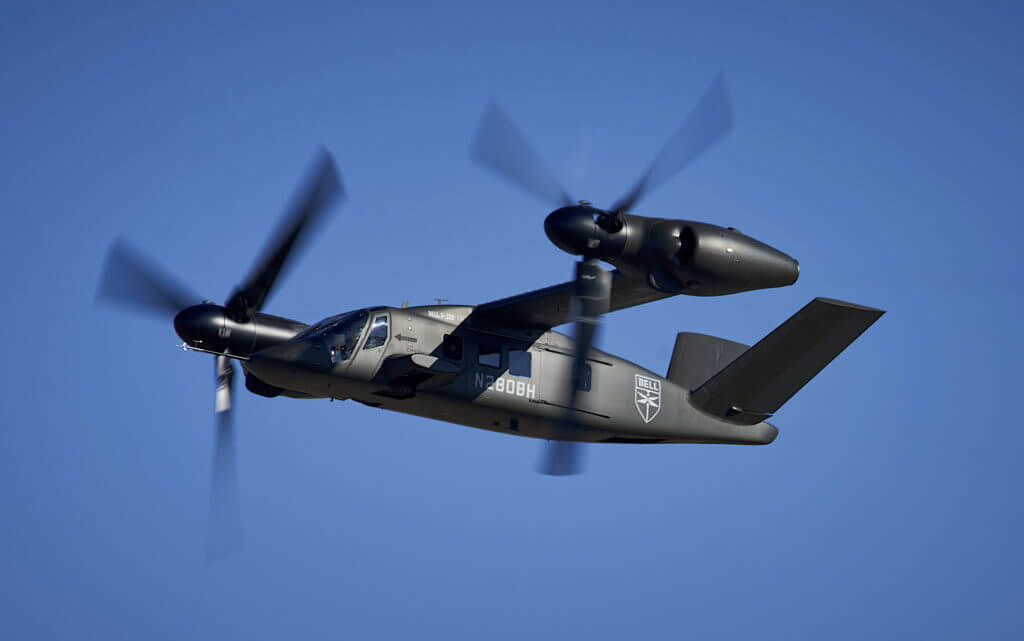With its designs under consideration as the U.S. Army’s next-generation rotorcraft, Bell is building a 140,000-square-foot laboratory to figure out how to actually produce the Future Vertical Lift aircraft.
Located near its Fort Worth, Texas, headquarters, the new Manufacturing Technology Center (MTC) is the nuts-and-bolts counterpart to the Flight Research Center where prototypes like the V-280, the original V-22 and commercial 525 were developed and first flown. The new MTC should be up and running in 2021.

The V-280 advanced tiltrotor is in the running for the Army’s Future Long-Range Assault (FLRAA) Aircraft while the yet-to-be-built 360 Invictus, a conventional helicopter with canted tail rotor and other futuristic modifications, is Bell’s pitch for the Future Attack Reconnaisance Aircraft (FARA).
“Everything that you’ve seen us do with the V-280 through the Joint Multi-Role effort, through the FARA effort, the Manufacturing Tech Center is another one of those key elements to show that Bell has both the capability and the capacity to handle programs of this magnitude,” Keith Flail, EVP for advanced vertical lift systems, said in a video the company released to announce the MTC.
That Joint Multi-Role Technology Demonstration (JMR-TD) program resulted in both the V-280 and its only competition, the Sikorsky-Boeing SB>1 Defiant coaxial compound helicopter. Now competing under the FLRAA program of record, one of the aircraft will eventually replace the UH-60 Black Hawk.
Valor has been airborne for two and a half years, racked up hundreds of flight hours and performed for both U.S. Army and government officials and the public. It has demonstrated forward flight at its namesake 280 knots (322 miles per hour) low-speed hover agility and flown autonomously.
The 360 Invictus, a smaller, single-main-rotor, tandem-cockpit attack aircraft is still being built for a flyoff against Sikorsky’s Raider X coaxial compound aircraft no later than fall 2023. The FARA aircraft will fill the operational gap left by retiring the OH-58D Kiowa Warrior armed scout helicopter.
With the MTC, Bell intends to develop manufacturing methods and processes to produce both aircraft at the fairly rapid rate the Army requires.
“We’ve proven what these aircraft can do,” said Bell president and CEO Mitch Snyder. “Now we’ve got to show that we can produce them at high rate, high quality and make them reliable and affordable.”
Digital connectivity and integration form the backbone of the MTC, Bell says. The entire facility will be monitored and controlled by a network of IT, Internet of Things (IoT) and cybersecurity systems that manage the inflow and outflow of materials, as well as the movement of activity throughout the factory. By deploying a networked software infrastructure, the MTC will produce a digital twin of itself that gives everyone a common operating picture of the building, the equipment and the processes.
“We realize that to produce the aircraft that the Army has asked for, that we have designed, in the quantities and timelines they’ve asked for, that we really need to think differently about our manufacturing,” said Robert Hastings, executive vice president of government affairs and communications. “So, this manufacturing technology center will allow us to evaluate the technologies that are available, to compare technologies, to bring them in from different parts of the world and different manufacturing suppliers to do our own but of innovation around manufacturing.”
Various areas of the large, warehouse-type building are dedicated to researching metrology, metals manufacturing, composites manufacturing, assembly and “connected worker”, shipping and receiving, automation lab, additive manufacturing and a visitor lobby/office area.
Bell intends to both innovate and simplify traditional manufacturing processes using additive manufacturing, comuterized design and logistics, among other strategies, according to Glenn Isbell, vice president of rapid prototyping and manufacturing innovation.
One example he gave in the introduction video is a gear manufacturing research line. Where the V-22 transmission bull gear requires 52 manufacturing processes to complete while the same gear in the V-280 can be built in 16 steps. Introducing similar efficiencies into its FVL production lines is a main goal of the MTC. Ultimately those innovations should “drastically reduce” cost, manufacturing steps and lead times, he said.
“The transition-to-production mission is the hardest thing we do in aerospace a lot of times, in most manufacturing,” Isbell says. “What this place, in a lot of ways, is designated and designed to do, is to enable us to transition those great designs of the 280 and the Invictus into the production side. … This is where we are going to develop all the next-generation manufacturing technologies that will enable 280, that will enable Invictus, that will enable Nexus, that will enable all things future at Bell.”
Nexus is Bell’s electric vertical-takeoff-and-landing air taxi concept and represents one of the ilines of effort that led the company in 2018 to drop “helicopter” from its name.
Aside from building the V-280, which was funded partially by the Army with hundreds of millions of internal research and development funding, Bell has made significant investment into its own infrastructure with projects like the MTC.
In May 2018, it opened the Advanced Vertical Lift Center (AVLC) outside Washington, D.C., where its larger defense contractor competitors have established flashy secondary headquarters near to the Pentagon and Capitol.









